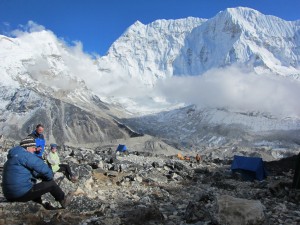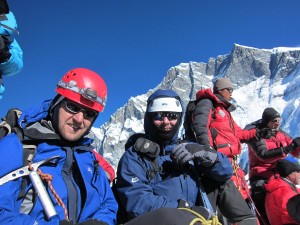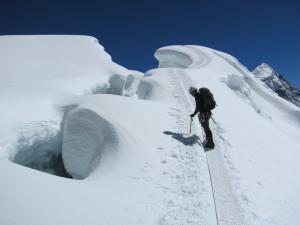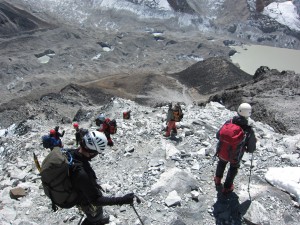Island Peak
Yesterday morning I wrote before we left Island Peak Base Camp. In the afternoon we climbed up to Island Peak High Camp, then this morning eight out of nine clients summitted at 6,189m. We’re now back at IPBC, utterly exhausted but hugely proud and satisfied.

The walk up was flat as far as the “real” IPBC which is situated by the enormous Imje Tsho lake (we used a lower camp, about an hour short of the main one, because the main one is apparently even colder than ours). From there it was a steep climb up to High Camp, which is at about 5,460m.
Rich and I ended up sharing with Andy this time, which was quite entertaining! We rigged up a zip wire for his teddy-bear, and talked a load of nonsense. I didn’t sleep brilliantly though, as the tent was a bit cramped and I was on the downhill side, with gaps underneath me and Andy and Rich rolling down onto me. I think I got a couple of hours sleep sometime after 23:00, but at 01:30 we were woken with “bed tea”.
Departure was scheduled for 03:00, so there wasn’t too much of a rush. We’d sorted out most of our kit the previous afternoon, so just had to eat breakfast and get dressed.
Getting dressed meant sports underwear, long johns, fleece salopettes, base layer, a thin fleece, a Primaloft jacket, a down jacket, two pairs of socks and a pair of plastic double boots, the inners of which had been in the sleeping bag overnight. On top of this there was a Gore-Tex hat, a helmet, gaiters, two pairs of gloves and a harness pre-arranged with Jumar, various karabiners, Prusik loops and a descender, all ready for action. Finally there were walking poles, and a rucksack including ice-axe, crampons, 4 spare pairs of gloves (different types and thicknesses), water, food, waterproofs and some emergency kit.
Luckily the weather was very kind to us again. There was a clear sky, and a full moon lighting up the mountain, but it was also surprisingly warm.

The climb began straight away: from our camp perched on the edge of the steep slope, we just carried on up the slope. We weren’t the first group to set off, and could see head-torches snaking up the path in front of us.
The first two hours were mostly some pretty straightforward scrambling but it was a relief to get a break after fifty minutes. My main concern was hydration, so I was drinking at every opportunity to try and stave off any symptoms of AMS.
After about two hours we reached the glacier. It seemed to take ages for everyone to attach crampons and rope together, but we set off before hypothermia or frost-bite set in, which was a relief. I was at the back of a rope with Tam Ding leading, and Dave and Mark in the middle.
The route across the glacier would look crazy on a map, unless the map showed the enormous crevasses we were walking round. We snaked round the huge holes, some visible, some covered with snow, climbing up and down massive banks of snow-covered ice, gradually zig-zagging in the vague direction of the headwall. As we crossed the glacier the sky began brightening and as we neared the head-wall the promise of sun meant that I stopped worrying about losing my toes from frostbite.
The approach to the headwall became steeper and steeper, until we reached the point where we switched from glacier-travel rope-groups to the fixed line. Crossing the glacier, we’d met a group of Austrians who’d got in the way, but Dowa had put in a fixed line especially for our group, so we didn’t have to fight with the other groups who were sharing another line.

I followed Dave, Mark and Thomas up the headwall. In my right hand I had my axe, and in the left my Jumar. My feet were mainly duck-footed, using the inside points of the crampons, occasionally switching to the front points, which work better on hard, steep surfaces, but are more tiring on the legs.
As we’d crossed the glacier I’d passed my previous altitude record (Kilimanjaro at 5,916m) but the headwall took it way higher: the fixed line ran from about 6,000m up to about 6,120m. I hadn’t read enough about Island Peak to know much about the route in advance, but it was amazing to find oneself climbing a long technical pitch at over 6,000m.
The biggest challenge was the physical one: simply lifting the body up the slope. After initially fighting it I began remembering my early days rock-climbing, stopped trying to haul myself up using the axe and started using the legs to climb, with the axe for balance and the Jumar for protection.
There were two mental challenges. The first was simply believing that you could keep going through the exhaustion, but the arrival of the sun helped with that. The second was navigating round the anchors, where the rope was attached to either the ice or another rope. On reaching an anchor, the safety karabiner is removed from the Jumar and attached to the anchor, so that there’s still some protection while the Jumar is switched from one side of the anchor to the other. Once the karabiner is in place, the Jumar can be released from the lower rope and attached to the upper rope, then the safety karabiner can be unhooked from the anchor and placed back through the handle of the Jumar and around the rope. This is all done in the semi-dark, wearing two pairs of gloves, at around -10°C, having already climbed for several hours up to 6,00m. And if it’s not done correctly, it could have nasty consequences for you and anyone lower down the rope.

I felt ridiculously slow up the headwall. Thomas seemed to be disappearing ahead of me and Tam Ding was right up behind me – so close that I worried that if I slipped I’d land crampons-first on top of him, so I kept the Jumar as tight as possible.
Eventually, after what seemed like a super-human effort, Dowa welcomed me onto the summit ridge, and I transferred to another fixed line for the final climb to the summit. This wasn’t nearly as steep as the headwall but was almost as slow, as we met up with the Austrians again. Both teams were clipping into fixed anchors at the summit, which lead to a queue on the final climb. I certainly didn’t mind the excuse for a breather though!
Finally, at about 08:30, all eight of us who’d set off from High Camp had arrived on the summit at 6,189m. The climb had been incredible, with a brilliant mix of scrambling, glacier-crossing, climbing, and finally a knife-edge ridge, all in the shadow of Lhotse’s south face stretching up to 8,501m
After a few photos and some antics with a French group who didn’t appear to have the first idea about safety, we climbed back down the ridge with just a safety karabiner attached and the rope running through our hands, then queued up for the abseil down the headwall.
By this time everyone was exhausted and just wanted to get down, so the mood wasn’t as positive as on the summit. Unlike the climb up, where several people can have a Jumar attached to the same rope, abseiling requires a loose rope below, so only one person can be on each section at a time, and the process seemed to take forever.
I was near the back, with just Thomas and Andy behind me. When we finally got down the fixed line, the three of us roped up for the glacier and wound our way back past the crevasses, which looked way more impressive and daunting in the sunlight than they had by the light of our head-torches.

At the bottom of the glacier we caught up with the rest of the group, removed our crampons, stowed them and the axes, drank as much as we could and set off down the rocks to High Camp. The strain was beginning to show, and Steve ended up giving his gear to Andy, Thomas and me, as he was beginning to suffer. By the time we reached High Camp, Mark was in a bad way too, which was a huge surprise as he’s been the strongest all trip.
We were re-hydrated with drinks and soup back at High Camp, then slowly packed up and began the descent to Base Camp. There was a biting wind blowing up the valley as we walked down, and it was a relief to get back to the shelter of the mess tent, where we were given more drinks. Most of the team had a snooze before dinner, and the banter during dinner was pretty limited. By 19:30 everyone had crashed out.
From my point of view, the contrast between the two climbs couldn’t be bigger. I don’t have any positive memories of Pokalde, but today’s climb is the highest and best I’ve ever done. I’m very relieved I didn’t have any AMS symptoms this time, very pleased to have got to the top of such a challenging climb, and extremely grateful that the weather was so good. To have clear skies and a full moon without the temperature being too bad was an ideal combination.
Finally I’m beginning to remember why we’re paying £3k for this!

